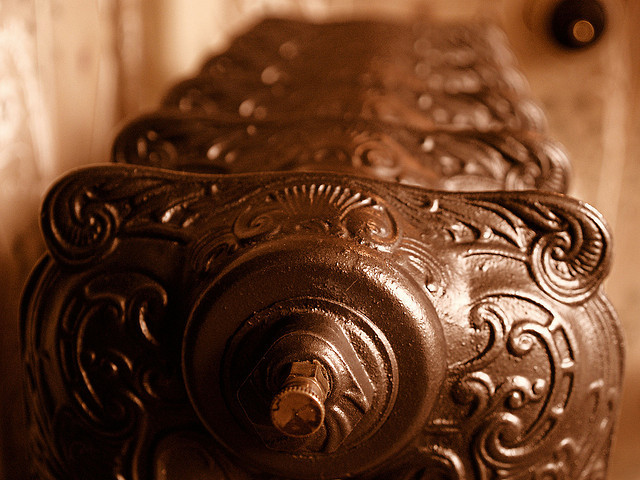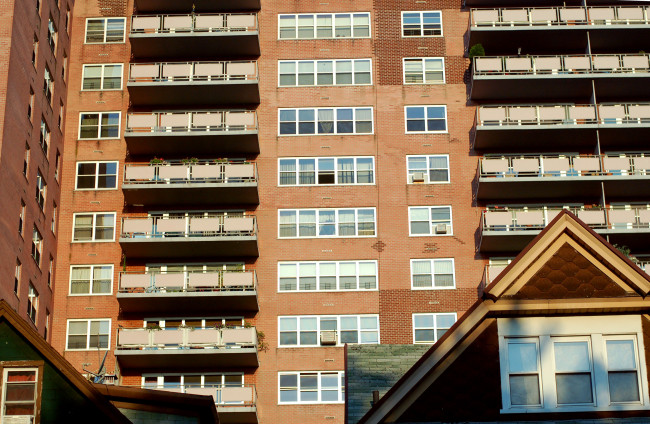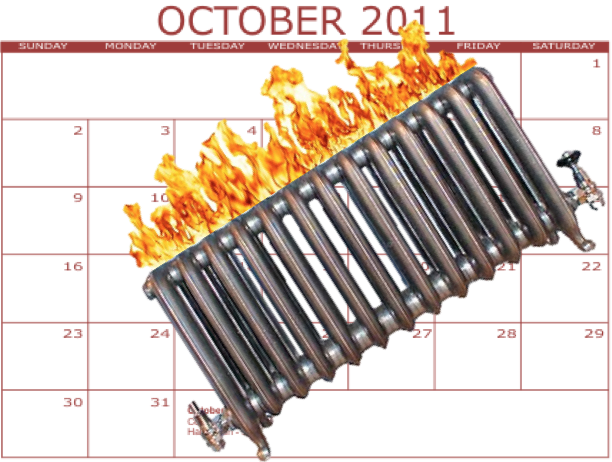Winter is coming: Talking with a techie activist who helps tenants get their heat turned up
New York City's heat season, when landlords must keep buildings warm to certain levels, officially started October 1st.
Looking forward to winter, remember that from now until May 31st, landlords must keep their buildings heated to at least 68 degrees if the temperature outside drops below 55 from 6 a.m.-10 p.m., and heated to 62 degrees overnight if the outdoor temp falls below 40 (the city just raised this latter requirement from a minimum indoor temperature of 55). The requirements are simple enough, but enforcement is hard to come by, because inspectors typically come days after a 311 call, and alert landlords before their visits, giving owners an opportunity to briefly turn up the heat before dialing it back down again. This makes withholding heat a favored tactic of predatory landlords seeking to drive out rent-regulated tenants.
Typically, tenant advocates advising renters with chronic heat issues tell them to keep a thermometer in the apartment, and log the temperature regularly with dates and times. A group of tech-minded recent college grads, thinking they could improve on this idea, got together in 2014 and started Heat Seek NYC, an organization that provides remote sensors to low-income tenants, and logs their apartments' temperatures over time in a central database, for use in demanding that heat be restored, and if necessary, printing out and bringing to housing court.
We spoke to Heat Seek director Noelle Francois about what the group has planned for this winter, and what she's learned from three years of heat tracking.
For the uninitiated, what does Heat Seek do?
We are a nonprofit civic activist organization working at the intersection of technology and affordable housing justice. We build and deploy low-cost, web-connected temperature sensors for tenants who are not receiving adequate heat in their apartments in the wintertime. We specifically work with tenants whose landlords are withholding heat as a form of tenant harassment, so we do a lot of work in gentrifying neighborhoods. This year we are opening up our work up a little bit to people who want them for other reasons as all, whose landlords maybe aren't intentionally harassing them, but still aren't providing adequate heat.
What got you interested in this work?
A few years before I moved to New York, I lived in a row house in D.C. that was very poorly insulated. We had plastic on the windows, and it would billow in the wind. No matter how high you turned the heat on, it was impossible to heat the house. So I became very familiar with electric blankets and sleeping in my coat. It stuck with me. It was really hard to get anything done, or be a productive person when it was that cold in the house.
Fast forward a couple of years later: I moved to New York, and I was in graduate school at NYU Wagner for their School of Public Service. And William [Jeffries], who is one of our co-founders, we went to undergrad together and were good friends in undergrad, so he was just starting up Heat Seek. He reached out to me because nobody else had ever worked at a nonprofit. Everybody else had worked in tech.
I first worked to facilitate a lot of partnerships with community organizations, and then got more and more involved. I was the first hire as well as the co-founder.
So you make the sensors yourselves?
We do. So we looked at what was available just for purchase, commercially available. One of the things that we realized really early on was that not all of the tenants we wanted to work with had internet access. A lot of the low-cost sensors are wifi-based or Bluetooth-based, so they were inaccessible to the tenants. Our first sensor model had a cellular connection through T-Mobile. We recently, thanks to a Google Community Grant, redesigned the sensors. And now we have a wifi and a cellular version.
You store the data as well?
We have a web app so all of the data that the sensors collect is sent to the web app. Our tenants get an account, so they can log in at any time on a graph that shows the indoor temperature, the outdoor temperature, and has an indicator for a reading that is in violation of the city housing code. So if a [Department of Housing Preservation and Development] inspector were to show up at that moment, the building would be in violation. They can also download a heat log like the hand-written one they would need to fill out if they were going to take the landlord to housing court. They can either send it to their landlord, use it in negotiations, or bring it to housing court.
In some instances printing it out is enough to get the heat turned back on. I hope that’s enough to get the heat back on. I hope that landlords see that and choose to fix their behavior, or do whatever they need to do to bring the building back up to compliance.
We've also had tenants who used this data in housing court. They either have a Legal Aid or Legal Services attorney who's representing them or their building in housing court. They’ll negotiate a stipulation with the landlord's lawyer saying they'll provide heat in compliance with the law.
We’ve had tenants get rent abatements for the time they weren't receiving the services. We’ve had tenants who've had the sensor and who’ve let their super know, "Hey, I've got a sensor, and it shows that there's not enough heat" and the heat comes back on. That’s our goal is that, once everyone knows what the temperature is in the building, the problem fixes itself, because people generally want to do the right thing.
Ultimately we'd like to help people avoid housing court altogether.
What need is the sensor filling that wasn't met prior to this?
Prior to Heat Seek, when tenants didn’t have heat in their apartments, tenants would call 311; 311 would kick the complaint over to HPD; HPD would send an inspector. But prior to sending an inspector, they would would call the landlord and say, "Hey someone just registered a complaint about the heat." Which makes a lot of sense if the landlord just doesn't know that the boiler is broken, or maybe the radiator isn't working. That gives them the opportunity to fix the problem.
But if the landlord is withholding heat to try to make the apartment less desirable so the tenant will want to move out, then now they know, "Someone's made a complaint, so now I need to bump up the heat for this 72-hour window when the inspector will come, so that I don't get caught. And then I can push it back down." What tenants were telling us is that it’s incredibly difficult to prove that you didn't have heat. It's not like leaks or mold, or something you can take a photo of. We needed some other way of documenting it. So that's where the sensors come in.
How many cases has your data been used in?
Probably 15 or 20 cases. We’ve been in about 100 buildings since we first got started in 2014. Obviously not all of those buildings choose to go to housing court.
And are all 100 still sending data?
We have a limited supply of sensors. We’re a nonprofit, so we’re not exclusively in the business of producing a product. We want to work with people to use the products. Each year we get requests from lawyers, from tenant organizers. We also get requests from tenants themselves. We’ll install the sensors, leave them in place for heat season and reclaim them at the end of heat season so that we can use them again the following year. We’re exploring the idea of letting people purchase one this year. We'll have wifi sensors to purchase this year.
This winter we'll have 60 sensors [total] to start out with. We’ve got 30 of them already made, and then we'll make another 30 in the next few weeks.
How can people get a sensor for their apartment?
If you need a sensor, fill out our request form. Due to high demand and limited capacity, we'll have a limited number of sensors available this year.
What should people do if they can't get one?
Call 311. Keep a log. Connect with a tenant organizer if it's a building-wide problem. Even if people feel like they haven’t gotten good results calling 311 in the past, it’s important to create an official log, and it becomes a record of how many complaints the city is receiving. If you were to go to housing court you could point to that and say, "This is how many complaints I’ve filed, and it still hasn't been resolved."
Has anyone, landlords say, questioned the integrity of your data?
No. We take a lot of steps to document how we install sensors, where we put them. We always get the question, "Oh, how do I know the tenant didn't put it in the freezer." We know that people don’t do that because we install them, put them on the wall, use tamper-proof tape on both sides of the sensor, so if they took it off the wall and moved it somewhere else, you’d see the tamper-proof tape had been broken and the residue on the walls.
We follow the HPD guidelines for [taking temperature readings]: not in a kitchen or bathroom, not in a room with an obvious draft, 3-5 feet off the ground. We want accurate data on the temperatures. So we're not sticking them on outside walls. We're not sticking them near windows. We really just want to help folks collect the actual temperature in their apartment so if it is too cold in their apartment they can get the problem resolved. And if it's not too cold, it's not illegally cold, they can understand that. They can say, "I feel cold, but it's not illegally cold. My landlord is meeting his obligation."
If the building is older and not well-insulated, doesn’t have new windows, it’s not going to be pressurized correctly, so it's going suck in cold air on the bottom floors, push out hot air on the top floors, and so it's going to be way colder on the bottom floors and hot on the top floors. That’s not a boiler problem, it's a sealant problem. If you feel like that may be an issue, the city has programs to provide upfront capital funding to do that. There's the NYC Retrofit Accelerator, and there's Bloc Power.
What's on the horizon for Heat Seek?
We’re about to start doing a bunch of installs. We had a volunteer night recently at NYC Resistor, which is a hardware hack space. We got a bunch of volunteers together, soldered a bunch of sensors.
We've already gotten a bunch of requests from people who have had heat issues in their buildings in the past, which we like because when it gets cold we always get slammed with requests.
We'll be installing a bunch of sensors through October, November, December, working with their lawyers and organizers to help facilitate them using the data to make change.
The last thing we want is for tenants to think, "Okay, now I have this sensor, and it's collecting data, so my problem's going to get solved." Collecting data is one piece of all this. It's step number one out of many steps. It's not a quick-fix solution. But it does make collecting the data, storing the data, managing it, presenting it in a way that looks user friendly to a judge—that's where we can help. And we can help connect people with legal services and community organizations through the resource map on our website.
We’re also looking at the opposite problem: of people overheating in their apartments in the summertime. That's a new line of work for us. We’ll be looking at what we can learn from leaving sensors in apartments over the summertime and continuing to collect data.
The Harlem Heat Project last year did some really interesting work. When they analyzed that data, they realized that a lot of those buildings made of really thick concrete were retaining heat even after the heat wave ended. So it could be dangerously hot in apartment buildings even after the city cooling stations closed.
Is there a maximum temperature legally?
No. It’s less a legal play and more a public health play. We want folks to understand. The city put out a report in July, Cool Neighborhoods NYC. They did all this research looking at who’s dying during these heat waves. 85 percent of people who died of heat stroke from 2008-2011 died indoors, not because they were out playing crazy sports or something during the heat wave. People inside their homes don't realize it's getting dangerously hot. It’s a lot of elderly folks who maybe they’re taking medications that make it so they can’t regulate their temperature. Or they're less mobile and can't get out of their house because it's too hot.
It's a real public health concern, and it’s only going to get worse as we start to really see the impact of climate change.
You Might Also Like



























